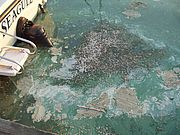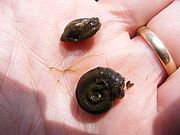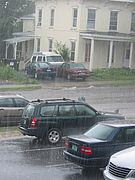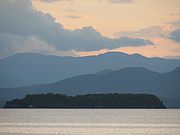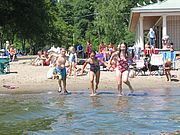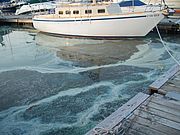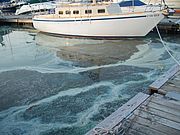Eurasian water milfoil (milfoil) is the bane of many a lake user. This aggressive non-native plant invades lake systems and spreads prolifically, choking out other plants and making swimming, boating, and fishing... Read...
News from Selected Month
What animal is more humble than a snail? They are the epitome of slowness. The dull-colored shells are easily overlooked within the lake and rarely studied, but snails are a source of food for 20% of freshwater fish species including sunfish and perch. There are approximately... Read...
If you’re thinking of fertilizing this fall, take time now to get a soil test to find out what it needs and help protect our waterways. Fall, not spring, is the best time to fertilize lawns in the Champlain Valley. You can obtain soil test kits through your area Extension Agency or by stopping by the LCC office...
Read...Get your copy by joining LCC or renewing your membership!
The 2010 edition of the Lake Champlain Paddlers' Trail Guidebook and Stewardship Manual is out! It’s jam-packed with important information for great adventures on the water including site descriptions and chartlets for 39 Trail locations (including several new sites!), launch site listings, natural history articles...
The Nature Conservancy (TNC) recently released a report titled “Climate Change in the Champlain Basin: What natural resource managers can expect and do,” one of the first efforts in North America to assess climate change on a watershed scale and offer adaptation strategies. LCC Staff Scientist Mike Winslow served as a reviewer on the report... Read...
On June 15th, a team with representatives from the EPA, Lake Champlain Maritime Museum, the McAllister Company and Phoenix Engineering conducted an observation of the sunken tugboat William H. McAllister. The team used a remotely operated submersible vehicle to search...
Read...The Department of Energy has determined that an Environmental Impact Statement (EIS) will be required... Read...
Algae blooms on Lake Champlain have calmed down since early July when a heat wave triggered blooms from Charlotte to Port Henry. Sampling done by LCC monitors during the week of July 26th reported no blooms in the northern lake, Missisquoi Bay, the Main Lake, or... Read...
Our blue green algae monitoring program got underway this week with citizen monitors taking samples at 18 shoreline locations. The current hot, steamy weather conditions are ideal for algae growth and they’ve led to extensive algae blooms particularly in Addison (VT) and Essex (NY) counties. Blooms have been reported in many areas from Burlington south to the Crown Point Bridge area, including Port Henry, Westport, Panton, Ferrisburgh, Kingsland Bay, Long and Thompson’s Points, around Juniper Island in the Main Lake and other locations. Shifts in wind and water currents will move the blooms around the lake and scums may accumulate on the shoreline so keep a watch on the water.... Read...
The hot steamy weather has led to reports of extensive algae blooms particulalrly in Addison (VT) and Essex (NY) Counties. Bloom conditions have been reported from Port Henry, Westport, Panton, Ferrisburgh, and Charlotte. A determination of the species involved in the bloom and whether or not they may be producing toxins is expected by the end of the week. Meanwhile, those recreating on Lake Champlain in all locations should watch for and avoid dense accumulations of algae. ... Read...

